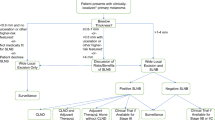Abstract
The most successful strategies in the management of melanoma have always been based on early diagnosis and timely surgical removal. Sentinel lymphonodectomy (SLNE) is the most reliable technique for the detection of melanoma micrometastases in regional lymph nodes. The micromorphometric S-classification, a routinely determinable surrogate of tumor burden in the sentinel lymph node (SLN), has high prognostic relevance. SIII metastases, defined by a depth of invasion (d) greater than 1 mm below the capsular level, imply a risk of more than 50% for the presence of nonsentinel lymph node metastases in the same basin and for the emergence of distant metastases within 5 years of follow-up. Corresponding risk with SI metastases (d≤0.3 mm) and SII metastases (0.3 mm<d≤1 mm) do not exceed 15%. The survival curve for patients with SIII metastases approaches that of patients in the pre-SLNE era who underwent delayed lymph node dissection for subsequently detected nodal macrometastases. The survival of patients with initially removed SI and SII metastases is much better, similar to that of patients with S0 metastases. This explains the significant survival benefit of SLN-guided surgery in the entire population of patients with melanomas thicker than 0.75 mm, although the outcome of the subgroup without nodal metastases is not influenced by SLNE.
Similar content being viewed by others
References
Virchow, R. Dritte Vorlesung. Allgemeine Physiologie der Geschwülste. In: Virchow R.Die krankhaften Geschwülste. Berlin: Hirschwald-Verlag, 1863:33–56.
Morton DL, Wen DR, Wong JH, et al. Technical details of intra-operative lymphatic mapping for early stage melanoma.Arch Surg 1992;127:392–9.
Cochran AJ, Balda BR, Starz H, et al. The Augsburg Consensus. Techniques of lymphatic mapping, sentinel lymphadenectomy, and completion lymphadenectomy in cutaneous malignancies.Cancer 2000;89:236–41.
Morton DL, Thompson JF, Essner R, et al. Validation of the accuracy of intraoperative lymphatic mapping and sentinel lymphadenectomy for early-stage melanoma: a multicenter trial. Multicenter Selective Lymphadenectomy Trial Group.Ann Surg 1999; 230:453–63.
Bachter D, Balda BR, Vogt H, et al. Die “sentinel” Lymphonodektomie mittels Szintillationsdetektor. Eine neue Strategie in der Behandlung maligner Melanome.Hautarzt 1996;47:754–8.
Bachter D, Balda BR, Vogt H, et al. Primary therapy of malignant melanomas: sentinel lymphadenectomy.Int J Dermatol 1998;37: 278–82.
Starz H, De Donno A, Balda BR. The Augsburg experience: histological aspects and patient outcomes.Ann Surg Oncol 2001; 8(9 Suppl): 48S-51S.
Starz H, Balda BR, Krämer KU, et al. A micromorphometry-based concept for routine classification of sentinel lymph node metastases and its clinical relevance for patients with melanoma.Cancer 2001;91:2110–21.
Cochran AJ, Starz H. Pathologic aspects. In: Cody HS III.Sentinel Lymph Node Biopsy. London: Martin Dunitz Ltd, 2002:79–90.
Volkenandt M, Schmidt M, Konz B, et al. Klinisch-epidemiologische Daten von Patienten mit malignen Melanomen aus dem Bereich des Tumorzentrums München von 1977 bis 1997.Hautarzt 1999;50:470–8.
Cascinelli N, Morabito A, Santinami M, et al. Immediate or delayed dissection of regional nodes in patients with melanoma of the trunk: a randomised trial. WHO Melanoma Programme.Lancet 1998;351:793–6.
Sleeman JP. The lymph node as a bridgehead in the metastatic dissemination of tumors.Rec Res Cancer Res 2000;157:55–81.
Balch CM, Soong S, Roos MI, et al. Long-term results of a multi-institutional randomized trial comparing prognostic factors and surgical results for intermediate thickness melanomas (1.0 to 4.0 mm). Intergroup Melanoma Surgical Trial.Ann Surg Oncol 2000;7:87–97.
Kretschmer L, Hilgers R, Möhrle M, et al. Patients with lymphatic metastasis from cutaneous malignant melanoma benefit from sentinel lymphonodectomy and early excision of their nodal disease.Eur J Cancer 2004;40:212–8.
Author information
Authors and Affiliations
Corresponding author
Rights and permissions
About this article
Cite this article
Starz, H., Siedlecki, K. & Balda, BR. Sentinel lymphonodectomy and S-classification: A successful strategy for better prediction and improvement of outcome of melanoma. Annals of Surgical Oncology 11 (Suppl 3), 162S–168S (2004). https://doi.org/10.1007/BF02523622
Received:
Accepted:
Issue Date:
DOI: https://doi.org/10.1007/BF02523622




